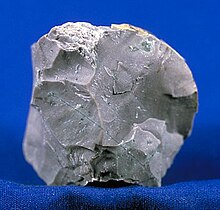
Back صخر صواني Arabic Chert Catalan Rohovec Czech Chert (Gestein) German Chert (roca) Spanish چرت (سنگ) Persian Chaille French Seirt Irish Tűzkő (üledéktípus) Hungarian Chert ID
| Sedimentary rock | |
 A hand sample of chert | |
| Composition | |
|---|---|
| Microcrystalline or cryptocrystalline quartz |
Chert (/ˈtʃɜːrt/) is a hard, fine-grained sedimentary rock composed of microcrystalline or cryptocrystalline quartz,[1] the mineral form of silicon dioxide (SiO2).[2] Chert is characteristically of biological origin, but may also occur inorganically as a chemical precipitate or a diagenetic replacement, as in petrified wood.[3]
Chert is typically composed of the petrified remains of siliceous ooze, the biogenic sediment that covers large areas of the deep ocean floor, and which contains the silicon skeletal remains of diatoms, silicoflagellates, and radiolarians.[4] Precambrian cherts are notable for the presence of fossil cyanobacteria.[5] In addition to microfossils,[4] chert occasionally contains macrofossils.[6][7] However, some chert is devoid of any fossils.[8]
Chert varies greatly in color, from white to black, but is most often found as gray, brown, grayish brown and light green to rusty red[9][10] and occasionally as dark green.[11] Its color is an expression of trace elements present in the rock. Both red and green are most often related to traces of iron in its oxidized and reduced forms, respectively.[4][12]
- ^ Knauth, L. Paul (1 June 1979). "A model for the origin of chert in limestone". Geology. 7 (6): 274–77. Bibcode:1979Geo.....7..274K. doi:10.1130/0091-7613(1979)7<274:AMFTOO>2.0.CO;2.
- ^ "Chert: Sedimentary Rock - Pictures, Definition, Formation". geology.com. Retrieved 12 May 2018.
- ^ Bates, R. L.; Jackson, J., eds. (1984). Dictionary of Geological Terms (3rd ed.). American Geological Institute/Doubleday. p. 85. ISBN 0385181019. OCLC 465393210.
- ^ a b c Boggs, Sam (2006). Principles of sedimentology and stratigraphy (4th ed.). Upper Saddle River, New Jersey: Pearson Prentice Hall. pp. 208–10. ISBN 0131547283.
- ^ Golubic, Stjepko; Seong-Joo, Lee (October 1999). "Early cyanobacterial fossil record: preservation, palaeoenvironments and identification". European Journal of Phycology. 34 (4): 339–48. Bibcode:1999EJPhy..34..339G. doi:10.1080/09670269910001736402.
- ^ Bonde, Suresh D.; Kumaran, K. P. N. (February 2002). "The oldest macrofossil record of the mangrove fern Acrostichum L. from the Late Cretaceous Deccan Intertrappean beds of India". Cretaceous Research. 23 (1): 149–52. Bibcode:2002CrRes..23..149B. doi:10.1006/cres.2001.0307.
- ^ Kotyk, M. E.; Basinger, J. F.; Gensel, P. G.; de Freitas, T. A. (1 June 2002). "Morphologically complex plant macrofossils from the Late Silurian of Arctic Canada". American Journal of Botany. 89 (6): 1004–13. doi:10.3732/ajb.89.6.1004. PMID 21665700.
- ^ Boggs 2006, p. 207.
- ^ W.L. Roberts, T.J. Campbell, G.R. Rapp Jr., "Encyclopedia of Mineralogy, Second Edition", 1990. ISBN 0-442-27681-8
- ^ R.S. Mitchell, "Dictionary of Rocks", 1985. ISBN 0-442-26328-7
- ^ McBride, E.F.; Folk, R.L. (1977). "The Caballos Novaculite Revisited: Part II: Chert and Shale Members and Synthesis". SEPM Journal of Sedimentary Research. 47. doi:10.1306/212F731A-2B24-11D7-8648000102C1865D.
- ^ Thurston, Diana R. (1972). "Studies on bedded cherts". Contributions to Mineralogy and Petrology. 36 (4): 329–334. Bibcode:1972CoMP...36..329T. doi:10.1007/BF00444339. S2CID 128745664.
© MMXXIII Rich X Search. We shall prevail. All rights reserved. Rich X Search